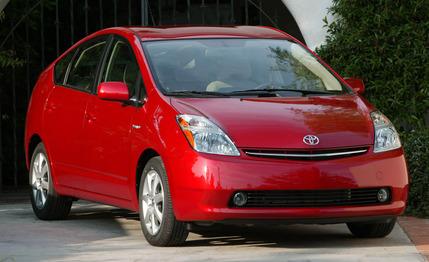
 Review
Review
Introduction
Perhaps the most famous of all gasoline-electric hybrids, the Toyota Prius soldiers into 2009 with few changes; a comprehensive redesign will happen for 2010. Launched for 2004, the current Prius’s sales numbers have risen and fallen with the price of gas. When Toyota launched the Prius, it predicted modest sales, but as gas prices rose toward $4 a gallon more recently, sales of the Prius shot past the 180,000-per-year mark.
There is no denying the Prius’s excellent fuel economy—the EPA predicts 48 mpg in the city and 45 mpg on the highway—but the appeal of the Prius goes beyond the numbers on the window sticker. Buying a Prius tells the world that you’re concerned about the environment, and the car’s unique shape makes it immediately identifiable to most of the public.
The key to the Prius’s fuel economy is the combined efforts of a small four-cylinder gasoline engine and two electric motors. Together, the gas engine and the electric motors make 110 horsepower and propel the Prius adequately. But the Prius isn’t about 0-to-60 times; indeed, the Prius requires a careful and delicate driver to deliver the best fuel economy. When the Prius is stopped, the gasoline engine usually shuts off. If the driver accelerates slowly, the gasoline engine remains off, as the Prius can pull away under the power of the torquey electric motors. The longer the gas engine is off, of course, the better the fuel economy, which is why the Prius gets better mileage in the low-speed city cycle. The Prius can run on battery power alone at speeds up to 25 or so mph; after that, the gasoline engine and the electric motors must share propulsion duties. A compact battery pack tucked beneath the rear seat powers the electric motors and is charged by the gasoline engine and through regenerative braking. Regenerative braking occurs when the car is coasting or coming to a stop, so whenever the Prius is decelerating, the electric motors work as a generator to charge the batteries.
In addition to the feel-good environmental statement the Prius makes, the car underneath is quite practical and refined. The hatchback body style is remarkably useful and provides an impressive amount of cargo space. Its back seat is also surprisingly spacious for a small car. The spaceship-like dashboard takes some getting used to, but it works well and adds to the uniqueness of the Prius. The Prius goes down the road with nary a fuss as its electric motors and gas engine switch back and forth unobtrusively.
Major competitors to the Toyota Prius include the Chevrolet Malibu hybrid, Honda Civic hybrid, Nissan Altima hybrid, Toyota Camry hybrid, and Volkswagen Jetta TDI. Next year, Honda will attempt to meet the Prius head-on with a dedicated hybrid model of its own, the 2010 Insight.
Verdict
The Prius is a unique, compelling, and practical entry in the hybrid class. Unlike its competition, the Prius looks unconventional and thus advertises its hybridness to the world. But aside from its looks, the Prius achieves its excellent fuel economy inconspicuously and demands few sacrifices from its owner.
Click here to read our full review of the Toyota Prius.
Click here to read our latest comparison test involving the Toyota Prius.
Click here to read our latest feature involving the Toyota Prius.
What’s New for 2009
Now in its final year before a comprehensive redesign, the Prius enters 2009 unchanged.
Highlights and Recommendations
The Prius starts at just under $23,000 for 2009, although it can easily rise toward $30,000 with options. Even at $23,000, the Prius costs about $6000 more than a similarly sized Toyota Corolla, a car that achieves an EPA-rated 35 mpg on the highway. The Corolla is a more prudent purchase in our book, but buyers seem to be happy to pay thousands of extra dollars to save a few bucks at the pump. The appeal of the Prius, it seems, transcends its parsimonious fuel economy.
Safety
Dual front airbags, front-seat-mounted side airbags, curtain airbags, anti-lock brakes, traction control, and tire-pressure monitors are standard on both Prius models, base and Touring. Electronic stability control is optional on both, which is a disappointment.